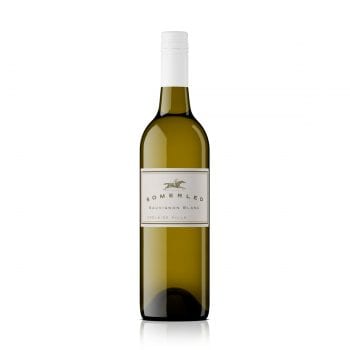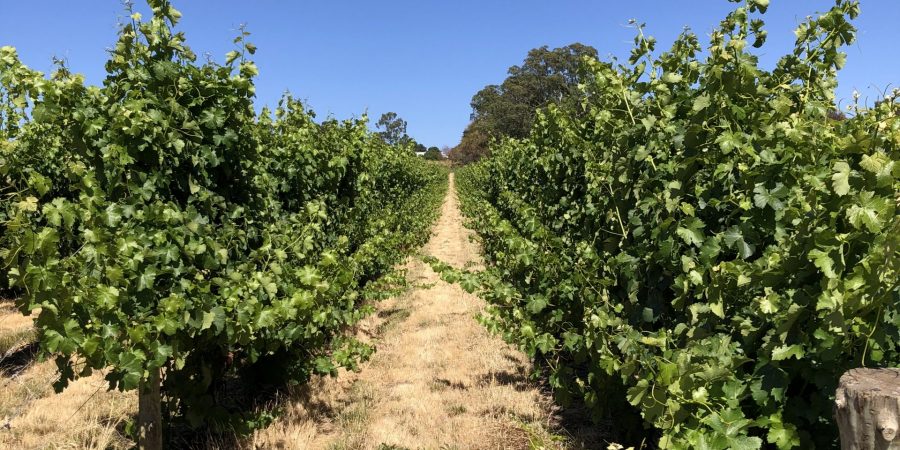Welcome back!
I hope you all had a fabulous festive season with plenty of good wine. And thanks for allowing me the luxury of a couple of weeks off! It was great.
Time for a little bit of catching up though…
Vintage 2021
 While we’ve had our feet up, vines across the Adelaide Hills (and other regions of course) have been hard at work.
While we’ve had our feet up, vines across the Adelaide Hills (and other regions of course) have been hard at work.
I think the last time I brought you a vineyard update much of the region was beginning or most of the way through flowering (between E-L 17 and E-L 25). Now, all varieties have set fruit and are heading into the final stage – berry ripening. As of last Wednesday, according to CropWatch, all varieties in the Hills were at E-L 33: berries still hard and green.
Need a growth stages reminder? Click here.
Vineyard update
Rob made a quick visit to Kim Anderson’s vineyard at Charleston on Monday. He was particularly interested in how the Sauvignon Blanc is coming along.
 You know… I don’t think we fully understood how much our crisp, fruity, easy to drink Sauvignon Blanc meant to you (and us!) until we didn’t have it. Ever since Kim’s vineyard was so badly affected by the December 2019 bushfires, this opinion dividing variety has been very much missed.
You know… I don’t think we fully understood how much our crisp, fruity, easy to drink Sauvignon Blanc meant to you (and us!) until we didn’t have it. Ever since Kim’s vineyard was so badly affected by the December 2019 bushfires, this opinion dividing variety has been very much missed.
Haters gonna hate… but for all the Sauvignon Blanc lovers out there you will be very pleased to hear that the grapes are growing beautifully. Kim expects to get around 3-4 tonne an acre from those vines. That’s plenty for us to make our 2021 vintage (with enough to share with another Hills favourite which also uses Kim’s fruit).
The thing Kim is happiest about is that his entire vineyard is showing no signs of disease. And this seems to be the trend right across the region.
Some vineyards experienced conditions favourable to downy mildew development early on in the season. However, our recent weather patterns have taken the pressure of f when it comes to this particular disease (although growers still need to be monitoring their crops for any signs of downy mildew).
Conditions hae been ideal for powdery mildew though (cool and overcast). Last week, Crop Watch reported signs of powdery in unsprayed trial sites in Lenswood over the previous two weeks, but there are yet to be any reports in working vineyards.
Perhaps a silver lining of the effects of bushfire? Or maybe it’s just the wine Gods smiling down on us for a change?!
Whatever it is, (and I don’t want to jinx it here, but) vintage 2020/2021 looks like it’s going to be a good one.
Why we love (and sometimes hate) Sauvignon Blanc…
 For those of you who are interested (which is all of you of course!), here are a few interesting Savvy tidbits!
For those of you who are interested (which is all of you of course!), here are a few interesting Savvy tidbits!
- Sauvignon Blanc is a white grape variety from western France. While the grape is more readily associated with the Loire Valley, it is more likely to have originated from Bordeaux. There it is typically blended with Semillon.
 In the late 20th Century, the Marlborough wine region in New Zealand started to gain a reputation as one of the great Sauvignon Blanc regions of the world. The rate at which its popularity grew is said to be one of the most dramatic events in the world of wine. In 2015, Sauvignon Blanc accounted for around 85% of New Zealand’s wine exports.
In the late 20th Century, the Marlborough wine region in New Zealand started to gain a reputation as one of the great Sauvignon Blanc regions of the world. The rate at which its popularity grew is said to be one of the most dramatic events in the world of wine. In 2015, Sauvignon Blanc accounted for around 85% of New Zealand’s wine exports.
- The key selling point of Sauvignon Blanc is its straightforwardness. The flavors are rarely hidden away in the background. It also produces wines that are pretty easy for us to get our heads around. There is a really close correlation between the flavours and their descriptors. If you’ve ever had a glass of Somerled Sauvignon Blanc there is no missing those tropical flavours that practically jump out of the glass at you.
- Sauvignon Blanc vines are relatively robust and vigorous – a viticulturalists dream. It adapts readily to all kinds of growing environments. Because it ripens early, it can be grown in relatively cool climates. Its naturally high acidity allows it to retain a level of freshness even in warmer areas. But the best Sauvignon Blanc wines come from a cooler climate with lots of sunshine and a dry harvest period. Just like the Adelaide Hills!
- Sauvignon Blanc has much in common with the red grape variety Cabernet Sauvignon. Not only does it share a name and region of origin, but both varieties are often described as herbaceous. The bell-pepper and asparagus flavors detectable in wines of both types are down to the methoxypyrazine flavor compounds in both varieties. They are also both vigorous growers that produce generous yields. The two varieties are, in fact, genetically related; Sauvignon became the parent to Cabernet Sauvignon after a natural crossing with Cabernet Franc. Both parent and offspring have now become two of the most widely planted vine varieties in the world.
Apologies to all the Sauvignon Blanc fans out there for that tease! But, I’m super excited to see this variety back on our list in the not too distant future.

